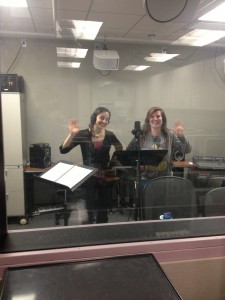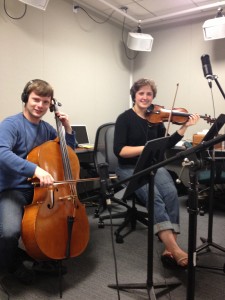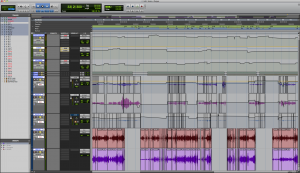Earlier this year, I was involved in a collaboration with West Chester University student choreographer Bailey O’Brien. The resulting piece of music I wrote, Sŭbra i Zaigra, was premiered on May 4, 2013 at “Danza Symbiotica” at the First Annual College of Visual and Performing Arts Festival. The music was heavily inspired by traditional Bulgarian folk music and texts, and (as anyone familiar with Bulgarian folk music would know) the music is very rhythmically difficult. I wrote the piece for 6 women singers, violin, ‘cello, and 2 percussionists, so coordinating the rhythmic complexity among this ensemble was likely to be a challenge. On top of this, the choir sings entirely in Bulgarian, something that I knew would be asking a lot of the performers.
These anticipated difficulties in producing a clean, accurate performance (one that had to be precise enough to dance to!) for a single presentation lead me to a more time-consuming, but long-lasting solution: to engineer a studio recording of the piece myself. Without having had any experience with such an ambitious task, there were bound to be many ‘bumps in the road.’ Thankfully, though, I had quite a bit of assistance and patience from the talented performers. Here is the finished recording that was played at the “Danza Symbiotica” performance:
Performing here are Natalie Dietterich, Theresa Whitehead, Soprano; Michelle Saddic, Emily Szal, Alto I; Jen D’Amico, Ally Hempelmann, Alto II; and Hope Linton, violin, Attila Szasz, cello.
The Recording Process
Trial and error was my primary teacher for this project.
Since I wanted to record each of the voice and instrument parts separately, I needed a click-track before I could record anything. Sŭbra i Zaigra is filled with both abrupt and gradual tempo changes and frequent meter changes. On top of this, I added extremely subtle shifts in tempo—things that I hoped would create the illusion of a live performance, ‘breathing’ with the piece. Each of these events had to be programmed into the software (Pro Tools), so that the performances I recorded with the musicians could be synchronized later.
We recorded the project in the Center for Music Technology at West Chester University—the equipment was all there, but it was up to us to assemble exactly what we needed for this project. After rehearsing the vocalists together to coordinate and match pronunciation, diction, and articulations, they split up, coming into the recording studio two at a time to record their parts. The recording room was separate from the mixing room, so I would stay with the performers to conduct and provide feedback. While I was here, another friend would work in the other room to queue up the take and listen to tuning, articulations, and releases against the other takes.
Since the vocals were recorded before the instruments, it became obvious that they needed a pitch reference for their entrances. So, for each of the takes, a single MIDI note (a sine wave) would play in their headphones just before their entrance, and the click track would continue. Though unfortunately an artificial way to match pitch, it was necessary to ensure that everyone was singing perfectly in tune despite recording several days apart.
The strings were the last thing to be recorded since I elected to use MIDI percussion—mostly due to time constraints. Like the vocalists, the performers played to a click track in headphones while I queued the different takes. Again, in the interest of performing in tune with the prerecorded vocals, we tuned to a sine wave.
Despite a few technological hiccups, we recorded extremely high-quality performances— all in time and all in tune. The next step was for me to edit and mix the many recordings.
The Editing/Mixing Process
Even though the performances were great, they weren’t all perfect— most problems were due to the artificial environment of the recording studio. It was up to me to make them sound perfect, though, in the editing stage. This involved lining up final consonants in the vocal parts, correcting miniscule tuning problems, and finding the best performance of every single measure. To do this, I worked on one part at a time, sifting though recording after recording to comp a “Frankenstein” performance of each voice or instrument part. Minute crossfades concealed the tiny edits I made, such as swapping one violin note for another. After this, I matched each perfected part to the others, correcting breaths, releases, and timing issues.
The final step was mixing the 7 different tracks into one— one that sounded like the performers were actively blending with each other as in a live performance. Again, I worked on each part separately, this time mixing the voices together, then the strings together, and finally the percussion. Each of these received automated adjustments to their relative volumes. After this, I mixed these 3 sections into one, again using automation that adjusted the relative volumes.
The Finished Recording
This project could not have been completed without the help of these amazingly talented (and patient) performers, Natalie Dietterich, Theresa Whitehead, Michelle Saddic, Emily Szal, Jen D’Amico, Ally Hempelmann, Hope Linton, and Attila Szasz. In addition, the assistance I received from Neil Chaban, Jonathan Lightcap, and Drew Walsh behind the scenes was integral. The late nights and long days were tiring for all of us, but only together could this recording have been possible. I must also thank Dr. Adam Silverman for his compositional instruction and Dr. Donna Buchanan for her book Performing Democracy: Bulgarian Music and Musicians in Transition. Thank you to you all! This is something truly special.




